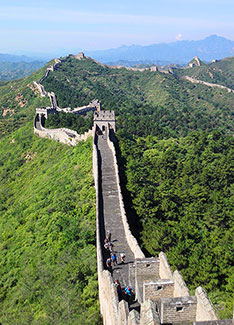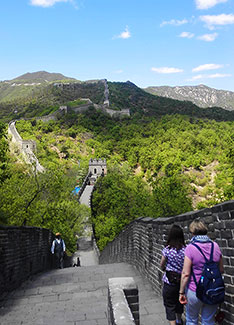
The Great Wall of China
An immense military defensive system stretching over 21,000 km, the Great Wall is one of the most universally-admired world heritages and the most iconic symbol of China. It is always the leading reason many travelers find themselves in China thanks to being in grand size, being built with integrated military functions, holding much history, snaking its way through many majestic mountain vistas, etc.
Overview
Originally built by Emperor Qinshihuang (the first emperor of China who should be given the award of ‘Best Contribution to Tourism' for ordering the construction of China's two most iconic monuments - the Great Wall and Terracotta Warriors and Horses ) to prevent the northern nomads from entering Chinese heartland, the Great Wall actually consists of a number of sections and passes that have been built throughout different ages (from 3rd century BC to the 17th century AD), endowing its history with rise and fall of several dynasties.
As a monumental military defense project, the Wall boasts of its comprehensive military facilities, such as the watchtower for transmitting message and providing shelter, fortresses for working as directed center, etc., providing a showcase for China's ancient architectural creativity.
Since the Wall spans east to west through 17 provinces along the northern border of the country which mostly runs through the rugged and steep mountain areas, being up on the wall will give tourists a shocking glimpse into many spectacular sceneries and some great hiking adventures.
Mutianyu:
Mutianyu Great Wall listed No.1 is not only because it is one of the best-preserved sections, but also the less crowded part. Quite accessible from Beijing and being equipped with cable car, chairlift, and toboggan ride, Mutianyu section is also family friendly. Zigzagging across the rugged forested countryside, Mutianyu is a bit wilder and less touristy than Badaling and Juyongguan, and boasts its breath-taking landscape.
- Round trip cable car.
The cable car will take you to the mountain top and you will get to Tower No. 14, where you can make your own choice which way to go. You could choose either to hike to east part to the highest spot of Tower No.23 with a medium physical difficulty. Or hike a bit to the east and then to the west. Whichever way to choose, you will need to come back to Tower No. 14 to take the cable car to get down.
- Ascend by cable car and descend by toboggan down.
Take the cable car up to Tower No.14 and do some hiking to the east part and then walk down to Tower No. 6 to take the toboggan down. (Speed of the toboggan is under your control and please slow down while turning and keep distance from other tourists.)
- Ascend by chair-lift and descend by toboggan down.
Get to Tower No.6 of Mutianyu Great Wall by a chair-lift and hike along the wall. Then get down by toboggan at the same tower.
- Entrance fee: CNY45
- Cable car (one way): CNY100
- Cable car (round trip): CNY120
- Ascent by chairlift and descent by toboggan: CNY120
- Descent by toboggan: CNY100
- The Wall has been renovated, making it fairly easy and safe to hike for even children and seniors.
- There are plenty shops and restaurants at the entrance.
Join in our Mutianyu Great Wall Tour to marvel at its spectacular view.
Badaling:
As the first section of Great Wall open to the tourists, Badaling offers perfect tourist facilities (including Great Wall Museum, Great Wall National Theater, restaurants, disabled accesses, cable cars, etc.), and is connected with Beijing by expressway, train, and many other convenient traffic options. Such easy accessibility means quite heavy crowds and high commercialization. But for those who travel independently, there will be no better choice than Badaling.

- Entrance fee: CNY45 from Apr. to Oct., CNY40 from Nov. to Mar.
- Cable car: CNY40 for one way, CNY60 for round trip
- A flat lane has been built in this section of Great Wall for wheelchair users easily ascend to the third watch tower.
Juyongguan:
One of the most important passes along the Great Wall noted for its soundness, Juyongguan is the closest section of Great Wall to Beijing (about 60 km away from Beijing). Just like Badaling, the Wall is reconstructed with original architecture features, and it is bound to be crowded due to its easy accessibility. For wheelchair users, this section is highly recommended as its wheelchair access is much better than any other sections.
- CNY45 from Apr. to Oct., CNY40 from Nov. to Mar.
Jinshanling:
Jinshanling section of Great Wall is semi-restored which covers both restored and wild walls, making for a fabulous opportunity to feel the original features of Ming Dynasty Great Wall. Featuring steep stretch and dense watchtowers, Jinshanling is far-less touristy than the completely restored sections of Great Wall close to Beijing and is extremely rewarding for those hiking lovers.

- Entrance fee: CNY65 from Apr. to Oct., CNY55 from Nov. to Mar.
- Cable car: CNY40 for one way, CNY60 for round trip
- Jinshanling is connected with Simatai to the east, and it is very popular to start a 4-hour adventurous hike from here to Simatai west.
- Sturdy shoes are necessary in this section for it is, in places, crumbling and steep.
Simatai:
Simatai is one of the few sections of Great Wall that retain the original appearance of Ming Dynasty Great Wall, offering tourists an immersive historic experience. It is the only section where you can enjoy an impressive night hike on the Great Wall. Due to the complex terrain in this area, battlements and watchtowers here are built in various styles and patterns, creating its unique charm.
- Entrance fee: CNY40
- Cable car: CNY90 for one way, CNY160 for round trip
- You need to pass through the Gubei Water Town (a place of interest with many leisure options where you can experience local culture, idyllic lifestyle, folk architecture, snacks, etc.) on your way to Simatai Great Wall.
- To fix in advance if you want to hike the Great Wall only.
- Currently, only the east section of Simatai is open to the tourists.
Huanghuacheng:
A partially restored section of Great Wall very close to Beijing, Huanghuacheng highlights its awesome scenery combining ancient Wall, mountains, and an artificial lake, and is far less crowded than other sections of Great Wall close to Beijing. It has become the latest popular destination for hiking lovers.
- CNY45
 Tips for Visiting:
Tips for Visiting:
-
When to go
- Tourists can visit the Great Wall all year round. If weather is your chief consideration, then spring and autumn are the most recommended time when the weather is quite mild and comfortable.
- In case of the heavy crowds, you are highly advised to avoid China's public holidays and weekends.
-
What to pack
- Dress appropriately according to the season of your visit. You are recommended to wear several layers for easy adding or removing clothes.
- Do wear comfortable and sturdy shoes due to the many steps and steep inclines in places.
- Bottled water and snacks are highly recommended for your hiking on most Great Wall sections will take hours.
- Do take some sunscreen products when visiting the Great Wall in a blazing or sunny day, like sunglasses, hat, sunscreen cream, etc.
After five-minute reading, you are now an expert of the Great Wall. Choose your preferred section and go to check out this great wonder of the world!









